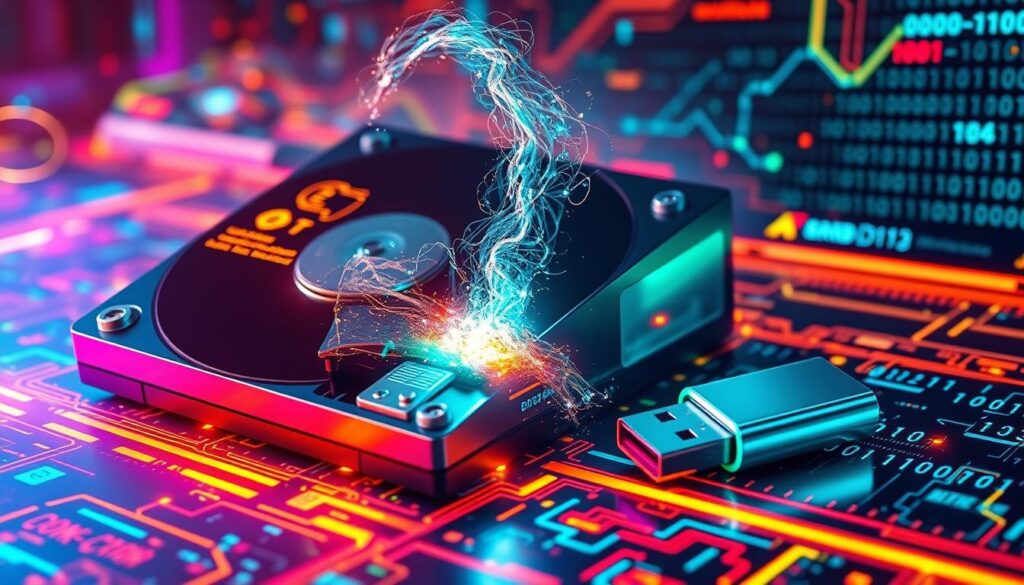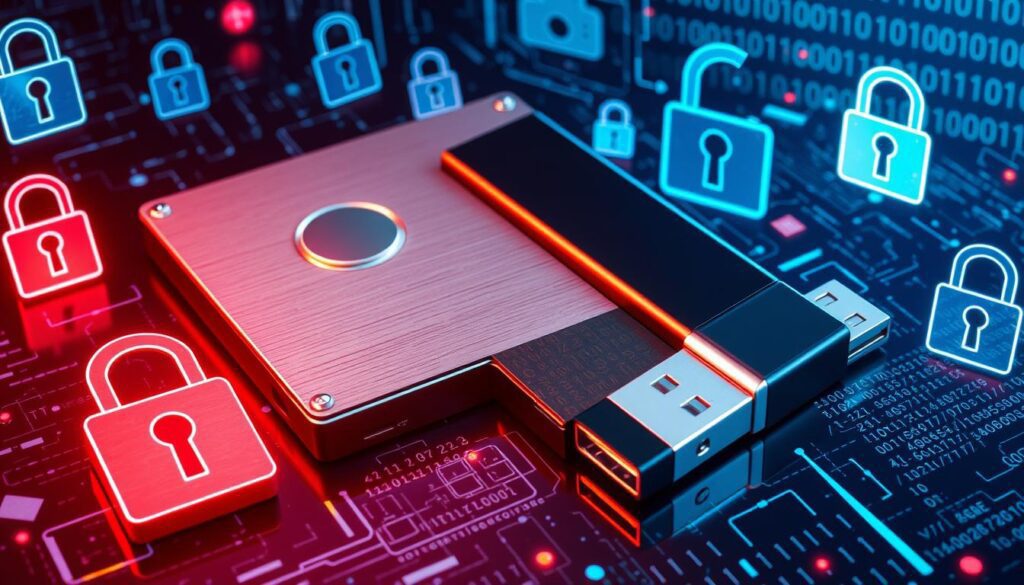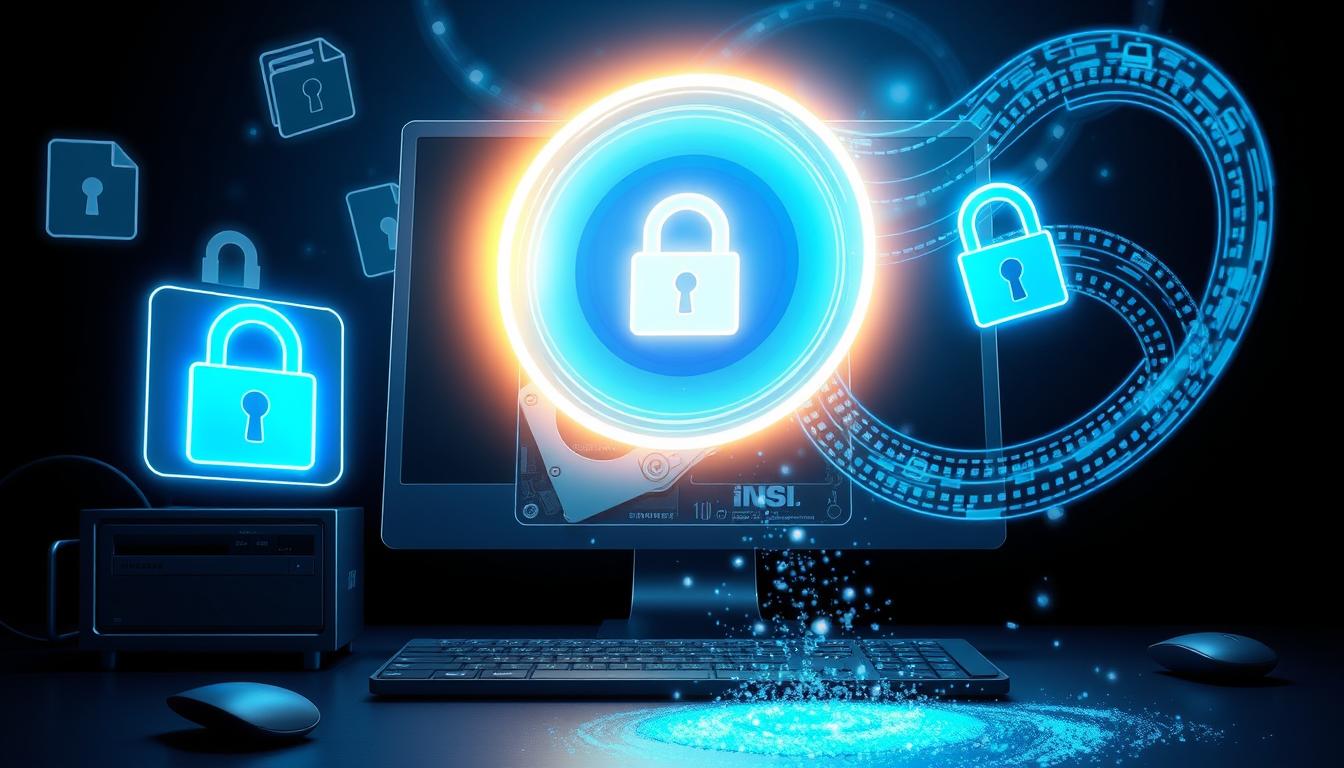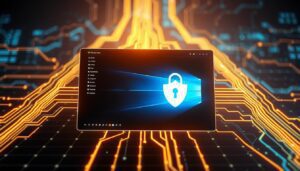How to permanently erase data on SSD HDD USB. In the digital world we live in now, the most important question is whether deleted things are really gone. Because of worries about privacy and the chance of information theft, it is important to know how to delete data safely. There are a lot of new strategies and technologies in this piece for solid-state drives (SSDs), hard drives, and USB flash drives. We work hard to make sure that private data is not only deleted, but can’t be recovered.
Data deletion’s permanence is often misunderstood. With the right tools, what appears as empty space on your devices could hold retrievable information. Our exploration of data wiping techniques aims to empower you with control over your digital footprint. Whether protecting personal or business data, using methods that make data irretrievable is crucial.
Key Takeaways
- The necessity of implementing secure data deletion methods to prevent data recovery.
- Understanding the vulnerabilities in standard data deletion practices, especially on SSDs, hard drives, and USB flash drives.
- An overview of data destruction solutions that provide peace of mind through irreversible data wiping.
- The role of sophisticated drive erasure software in achieving compliant data sanitization.
- An introduction to the criteria in selecting robust data erasure tools and services for reliable data destruction.
How to Know How Important Data Security Is
In the present quick moving computerized age, safeguarding your information has never been more significant. With digital assaults and information breaks turning out to be progressively normal, defending delicate data is a top concern. That is the reason utilizing information disinfection techniques and secure record erasure apparatuses is so significant they assist forestall unapproved admittance to your information while guaranteeing consistence with legitimate security principles.
A company’s reputation might be harmed and significant financial losses can result from improper data management. You can totally erase files from your devices and render them unrecoverable by employing trustworthy data sanitization techniques. These tools are crucial for protecting your erased files from restoration or misuse.
- Prevent data breaches.
- Maintain compliance with legal requirements.
- Protect sensitive and proprietary information.
- Instill consumer confidence through demonstrated data security.
Effective data security relies on choosing the right tools and regularly updating practices. For both individuals and large corporations, the risks of poor data protection are too high to ignore.
Looking at past instances, we see the importance of using advanced data sanitization techniques and secure file deletion tools. It’s not just about meeting regulations; it’s a key part of digital security.
Implementing these security measures reduces risks in data handling and storage. Companies should regularly review their data security plans. They should adopt technologies that ensure complete data disposal security.
The Challenges of Data Deletion in Different Types of Storage Devices
Securely deleting data faces unique hurdles across various storage devices. It’s vital to grasp these challenges for safeguarding sensitive information from unauthorized access.
The Unique Nature of SSDs in Data Deletion
Solid-state drives (SSDs) differ from traditional magnetic hard drives. They store data using integrated circuits. This distinction impacts how data deletion is managed. SSDs employ wear leveling to distribute data evenly, enhancing their lifespan. Yet, this technology scatters data fragments, complicating complete data erasure.
Conventional data wiping tools often struggle with SSDs. This is due to their architecture. Specialized methods are needed for effective data sanitization on SSDs.
Comparing Hard Drives and USB Flash Drives in Secure Data Wiping
Hard drives and USB flash drives, despite their magnetic storage, demand unique approaches for data sanitization. Hard drives, with their larger capacities and extended data storage, pose challenges in the wiping process. In contrast, USB flash drives, used for transferring data, are sanitized more frequently but face similar issues with data residue.
For those looking to ensure data irretrievability, disk sanitization services offer a comprehensive solution. These services stick to standards like the U.S. Department of Defense’s DoD 5220.22-M method. They ensure data is completely erased. For businesses with diverse storage needs, professional services enhance security and meet legal data privacy standards.
The significance of using data wiping tools and disk sanitization services is paramount. These tools and services are crafted to address the complexities of different storage technologies. Given the unique nature of each device, a universal solution does not exist. Therefore, selecting the appropriate tools and services is crucial for robust data security.
Preparatory Steps Before Wiping Your Storage Device
Before starting secure data deletion, several preparatory steps are necessary. These ensure the process is done correctly and meets all data protection laws. Without proper preparation, you risk losing valuable data and exposing sensitive information. This could violate data destruction solutions protocols.
- Backup Your Data: The first and most crucial step is to backup any important files. Data loss can be irreversible if files are not duplicated elsewhere.
- Verify Ownership: Ensure the digital media to be destroyed is legally yours. This prevents legal complications involving data ownership rights.
- Document the Data: For compliance with many industry standards, it’s necessary to document what data is held on the device and how it’s going to be removed.
- Review Compliance standards: Whether HIPAA, GDPR, or CCPA, understanding and following to legal standards is crucial for organizations to avoid penalties.
These measures are critical to mitigate any dangers related with secure data deletion and data destruction solutions.
The Role of Data Sanitization Techniques
In the world of data security, it’s vital to grasp and apply effective data sanitization techniques. These methods ensure information is completely destroyed. Data sanitization goes beyond simple deletion or formatting. It uses advanced drive erasure software for a deeper level of secure data deletion.
Data Sanitization: What is It?
Information sterilization is the course of deliberately, for all time, and irreversibly eliminating information from a memory gadget. This makes the information unrecoverable. It’s a more secure method than deletion or formatting, which often leave data traces behind.
Standards and Procedures for Effective Data Sanitization
Several standards ensure data sanitization’s effectiveness. The DoD 5220.22-M standard is notable. It outlines a method for securely erasing data. This involves overwriting the data with specific patterns multiple times, making it unrecoverable.
| Standard | Description | Overwrite Passes |
|---|---|---|
| DoD 5220.22-M | U.S. Department of Defense method for secure data deletion | 3 |
| NIST 800-88 | Guidelines for media sanitization | Variable |
| ISO/IEC 27040 | Standard providing guidelines on data storage security | Defined by user’s security policy |
Drive erasure software often meets these standards, offering a reliable solution for secure data deletion. It facilitates the sanitization process across various storage devices. This ensures compliance with global security standards.

Effective data sanitization through drive erasure software secures confidential data. It also boosts trust and compliance, essential for modern digital businesses. Therefore, selecting the right software and understanding the standards it adheres to is key in a robust data security strategy.
How Software Can Help with Safe Data Erasure
In the present computerized world, it is critical to safeguard delicate data. Programming is key in guaranteeing information is totally obliterated when it’s not generally required. This section looks at how data wiping and secure file deletion tools work. We focus on both open-source and commercial options.
Evaluating Drive Erasure Software
Choosing the right drive erasure software is essential. Look for tools that are reliable, compatible with various storage types, and have certifications. These certifications attest to the software’s compliance with strict data destruction guidelines, such as those issued by the National Institute of Standards and Technology (NIST).
Both SSDs and conventional hard drives should be supported by safe file deletion software. This ensures data is completely gone after deletion. The right software should make data unrecoverable.
Open-Source vs. Commercial Data Destruction Solutions
The decision between open-source and commercial data wiping tools depends on your needs and resources. Open-source software is flexible and open, allowing for customization. But, commercial solutions often offer better support and updates, crucial for staying safe from new threats.
| Aspect | Open-Source Tools | Commercial Tools |
|---|---|---|
| Cost | Often free | Subscription or one-time fee |
| Customizability | High | Limited |
| Support | Community-based | Dedicated technical support |
| Updates | Varies | Frequent and automated |
Deciding on the right data destruction method requires understanding the differences between software types. Whether open-source or commercial, the goal is the same: to securely erase sensitive data without any chance of recovery.
Physical Destruction: When Software Isn’t Enough
Data destruction solutions and disk sanitization services often use software. However, there are times when physical destruction of storage devices is necessary. This section will look at different physical destruction methods and when they are needed.
Methods like shredding, degaussing, and incineration offer the highest data security. They physically break down storage media, making data unrecoverable. This is more effective than software-based erasure, which may leave data remnants.
- Shredding: Mechanically cuts disks into small pieces, making any attempt to retrieve data practically impossible.
- Degaussing: Uses powerful magnets to disrupt the magnetic fields in storage devices, thereby erasing the data contained within.
- Incineration: Completely burns the device, destroying both the physical form and the data simultaneously.
Certified disk sanitization services suggest physical destruction for damaged devices or highly sensitive data. It’s important to ensure the services meet national and international data destruction regulations.
| Method | Use Case | Compliance Standards |
|---|---|---|
| Shredding | High-volume storage environments where disks must be quickly and completely destroyed. | NIST SP 800-88 |
| Degaussing | Environments dealing with highly sensitive data that requires immediate neutralization. | DoD 5220.22-M |
| Incineration | End-of-life data destruction where recovery must be impossible. | GDPR Compliant for data destruction |
The choice between software and physical data destruction depends on security needs and regulations. Disk sanitization services offer both options to meet various client requirements. They ensure compliance with data protection standards.
How to Delete Data from USB Flash Drives, Hard Drives, and SSDs Permanently
To guarantee delicate information is totally eradicated from capacity gadgets, demonstrated strategies are vital. Whether using specialized software or manual techniques, the choice depends on the device type. Here’s a guide on how to securely wipe different storage devices to protect your data.
SSD Data Erasure Methods
For solid-state drives (SSDs), using secure erase commands like TRIM is crucial. TRIM enhances read and write functions and, when paired with erasure software, makes SSD data unrecoverable. Specialized SSD erasure tools also offer a reliable wipe method.
Permanent Deletion Techniques for Hard Drives
Magnetic wiping, or degaussing, is effective for hard drives. It disrupts the magnetic fields, making data unreadable. For more extreme cases, physical destruction guarantees complete data loss. Yet, for less severe options, erasure software that overwrites data with random information is a secure choice.
Ensuring Complete Data Removal from USB Flash Drives
USB flash drives are particularly challenging due to their portability and increased risk. Encrypting data before deletion adds security. Then, using data wiping tools for multi-pass overwriting ensures data recovery is impossible. This method meets strict data protection standards.
| Storage Device | Data Erasure Method | Tool/Software Recommendation |
|---|---|---|
| SSD | TRIM Command, Secure Erase Utilities | Drive Erasure Software |
| Hard Drive | Magnetic Wiping, Physical Destruction | Specialized Magnetic Degaussers |
| USB Flash Drive | Encryption, Multi-Pass Formatting | Advanced Formatting Tools |
Selecting a Data Wiping Tool: Important Considerations
In the digital world of today, data breaches are frequent. As a result, selecting safe and efficient data deletion and sanitization processes is essential. Understanding the features of a reliable data wiping tool is key to avoiding security risks.
Key Features of Effective Data Wiping Tools
When picking a data wiping tool, several key elements are crucial. First, the tool should meet global data sanitization standards for secure data deletion. A user-friendly interface, along with detailed logs and reports, ensures transparency and ease of use. This guarantees the process’s integrity.
Compatibility with various storage mediums like SSDs, HDDs, and USB drives is also important. The tool should offer a range of data sanitization techniques. This range should include basic file deletion to advanced algorithms for complete data erasure.
Recommended Secure File Deletion Tools
Choosing a tool with positive industry reviews and certifications is crucial. It ensures the tool follows advanced data sanitization techniques. Here are some top secure file deletion tools:
| Tool Name | Type | Supported Devices | Compliance Standards |
|---|---|---|---|
| Eraser | Open Source | All types of HDDs, SSDs, and USBs | DoD 5220.22-M, Gutmann |
| Stellar BitRaser for File | Commercial | SSDs, HDDs | NIST 800-88 |
| Blancco Drive Eraser | Commercial | All types of HDDs and SSDs | Multiple Global Standards |
When choosing a data wiping tool, ensure it fits your storage device needs. Also, confirm its adherence to recognized secure data deletion methods and data sanitization techniques.

Data Wiping Services: When to Call in the Experts
At times, managing data destruction internally falls short of the high standards needed for complete security and compliance. This is where disk sanitization services and data destruction solutions become crucial. These services ensure data is handled and destroyed according to industry norms. They also provide a certificate of destruction, essential for audit trails.
Deciding to use professional disk sanitization services hinges on several key factors. If the data volume is substantial, the storage devices are complex, or specific regulations must be followed, seeking expert help is wise. It’s often necessary.
| Scenario | Benefit of Using Professional Services |
|---|---|
| Large volumes of data | Efficient and secure handling without impacting business operations. |
| Varied device types | Customized approach to cater to different storage media. |
| Regulatory compliance needed | Certified data destruction that complies with legal standards. |
| Certification required | Provision of certificates for compliance audits, verifying data integrity. |
Choosing data destruction solutions means ensuring adherence to environmental policies on e-waste. Professional services keep up with technological and regulatory shifts. They offer peace of mind, knowing data sanitization is done flawlessly.
In conclusion, whether it’s to protect sensitive information or meet strict industry standards, professional services for disk sanitization are essential. They guarantee data destruction is complete, leaving no trace of data behind.
Conclusion
Strong security is essential in the digital world, particularly when handling sensitive data. The specifics of permanently erasing data from USB flash devices, hard disks, and SSDs have been covered in this article. This knowledge is essential for privacy and security in our digital lives. With so many storage devices out there, each requires a unique approach for secure data deletion methods.
At the start, we highlighted that regular deletion methods are not enough to ensure data is gone for good. Specialized tools, physical destruction, or professional services might be needed. Understanding data sanitization techniques and the differences between storage mediums is key to avoiding data recovery by unauthorized parties.
We aim to equip you with the knowledge to actively protect your data. By using effective methods to permanently erase data, you keep your personal and professional information safe from breaches. Remember, protecting data privacy is an ongoing task. It goes beyond just using your devices; it includes when you decide to get rid of them. So, take the necessary steps, follow the recommended practices, and know that your digital presence is secure, even after your data has fulfilled its purpose.
FAQ
What justifies the need to permanently erase data from capacity devices?
Erasing data from devices such as USB flash drives, hard drives, and SSDs is essential for preserving personal and secure innovation. It prevents unauthorized access and prepares for protected innovation burglary, wholesale fraud, and information leaks.
Why is information security so important in today’s sophisticated world?
In the modern day, sophisticated knowledge is both important and powerless to prevent abuse and robbery. Ensuring the categorization, integrity, and accessibility of data requires information security. It reduces the risks of information breaches and fosters confidence in online cooperation and communication.
As far as information obliteration, how are SSDs not the same as USB streak drives and hard plates?
SSDs are not quite the same as traditional hard drives in that they utilize streak memory and have no moving parts. Certain methods, for example, the TRIM order or secure wipe programs, are expected to erase information from SSDs. Hard drives and USB flash drives can be wiped using magnetic wiping or secure formatting.
What are the preparatory steps before wiping a storage device?
Before wiping a device, back up important files and ensure you own the device. Also, comply with data destruction regulations. Choose the safest way to remove data from your storage medium.
What is the difference between basic data deletion and data sanitization?
Data sanitization guarantees that information is lost forever and cannot be recovered. It goes beyond straightforward formatting or deletion, which may still allow for data recovery. Techniques like overwriting, degaussing, or physical destruction remove data’s possibility of reconstruction.
What standards and procedures should effective data sanitization comply with?
Compelling information sterilization should stick to perceived guidelines and techniques. This incorporates the DoD 5220.22-M norm, NIST Exceptional Distribution 800-88, or industry-explicit rules. These ensure data is thoroughly and irreversibly destroyed.
How do I evaluate drive erasure software?
When evaluating drive erasure software, consider reliability, ease of use, and compatibility. Also, ensure it meets data sanitization standards. Look for software that offers verification to confirm data erasure.
What are the differences between open-source and commercial data destruction solutions?
Open-source solutions offer transparency and are often free or low-cost. Commercial solutions provide additional support, updates, and certification required for compliance with regulations.
When might physical destruction of storage media be necessary?
Physical destruction is necessary when software methods fail or for storing highly sensitive data. It’s also used for old or damaged devices where software methods are not feasible.
What specific methods ensure the permanent erasure of data on SSDs, hard drives, and USB flash drives?
For SSDs, use manufacturer-specific commands or software that sends the TRIM command. Hard drives can be wiped securely through magnetic wiping or physical destruction. USB flash drives can be erased through encryption and formatting or physical destruction.
What features should I look for in an effective data wiping tool?
An effective data wiping tool should be easy to use and support various devices. It should provide clear evidence of sanitization and meet recognized standards. It should also offer a certificate or report verifying data erasure.
What are some recommended secure file deletion tools?
Recommended tools include DBAN for personal use, Blancco for enterprise, and Eraser for Windows. Verify the tool’s suitability for your device and compliance with standards.
When should professional data wiping services be considered?
Consider professional services for large data volumes, special regulatory needs, or a certified process. They offer convenience and assurance for those lacking expertise or equipment.







The depth and breadth of your knowledge on this topic is truly impressive. Well done!